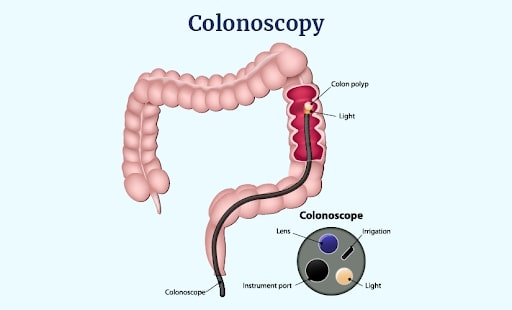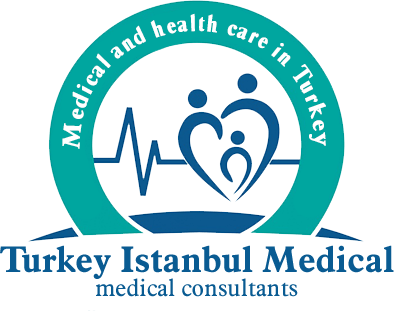What is Colonoscopy?
Colonoscopy is an endoscopic procedure that allows viewing the inner surface of the intestines with a device called a colonoscope and, when necessary, removing suspicious tissues and examining them in a laboratory environment. Colonoscopy, which is also used to intervene in existing bleeding in the large intestine, which is the last part of the digestive system, and to treat early-stage colon cancer formations, is a short-term procedure that does not require hospitalization.
Colonoscope device, which allows detailed visualization of the rectum and large intestine by entering through the anus, 1 cm. in diameter and approximately 60 cm. It consists of a long flexible tube.
Thanks to the cold light source and optical imaging system at the end, the images obtained are reflected on the monitor and simultaneously recorded on the computer.
In the light of the images obtained, the physician can diagnose many problems in the large intestine. It can also be applied to examine the relevant tissue in detail in a laboratory environment by taking a sample tissue piece from the suspicious area, or in other words, by performing a biopsy.
Why is Colonoscopy Performed?
Your doctor may recommend a colonoscopy for the following reasons:
-
Investigating the Cause of Intestinal Signs and Symptoms:
Colonoscopy can help your doctor discover possible causes of abdominal pain, rectal bleeding, chronic constipation, chronic diarrhea, and other intestinal problems.
-
Colon Cancer Screening:
If you are age 50 or older and at average risk for colon cancer with no colon cancer risk factors other than age—your doctor may recommend a colonoscopy every 10 years to screen for colon cancer, or sometimes sooner. Colonoscopy is an option for colon cancer screening. Talk to your doctor about your options.
-
Investigating the Presence of Polyps:
If you have previously developed polyps in your intestines, your doctor may recommend a follow-up colonoscopy to look for any other polyps that may be present and remove them. This type of colonoscopy is done to reduce your risk of colon cancer.
In Which Diseases is Colonoscopy Performed?
-
For Diagnostic Purposes:
Colonoscopy can be performed to diagnose problems in the intestine.
- Persistent abdominal pain
- Rectal bleeding
- Chronic constipation
- Unexplained anemia, i.e. anemia or iron deficiency
- Chronic diarrhea
- Cancer
- Unexplained weight loss
Colonoscopy should be performed in case of symptoms such as:
-
Colon Cancer Screening:
Even if there are no complaints, colonoscopy should be performed for early diagnosis of colon cancer and rectum cancer. Colonoscopy is recommended every 5 years for people over the age of 50. The frequency of colonoscopy may vary for people with a family history of colon or rectal cancer.
-
Polyp Control:
People who have previously had intestinal polyp problems may need to undergo colonoscopy check-ups at regular intervals. Early diagnosis and removal of intestinal polyps during colonoscopy is one of the most important ways to protect against bowel cancer.
What are The Side Effects of Colonoscopy?
Colonoscopy is a very safe procedure.
However, sometimes the following negative situations may occur during or after the procedure;
- Bleeding
- Inflammation
- Diverticula (outward herniation of the large intestine wall).
- Severe abdominal pain.
- Negative reaction to the sedative given during the procedure.
- Tear (perforation) in the wall of the large intestine or rectum.
What is The Difference Between Colonoscopy and Virtual Colonoscopy?
Colonoscopy and virtual colonoscopy are two different medical imaging methods used to evaluate the lining of the large intestine (colon) and rectum. They differ in terms of their functioning and results.
Colonoscopy:
- Colonoscopy is performed by passing the colonoscope, a flexible tube, through the anus and advancing it into the colon.
- The colonoscope has a camera and light source inside so the doctor can view the intestinal wall in detail.
- The colonoscope may also be used for polyp removal, biopsy taking, or other interventions.
- Since colonoscopy is performed in real time, polyps or abnormalities can be detected immediately and treatment can be administered if necessary.
- Colonoscopy is an invasive procedure and is usually performed under sedation.
Virtual Colonoscopy (Computed Tomography Colonography – BTK):
- Virtual colonoscopy is the creation of 3D images of the inner surface of the colon using a computed tomography (CT) scan.
- This Virtual colonoscopy may be an alternative to colonoscopy, but it is not a replacement for a full colonoscopy. In some cases, it can be used to determine the presence of polyps or abnormalities.
- Virtual colonoscopy is a non-invasive procedure. A CT scan is performed by injecting air or sometimes contrast material into the rectum, rather than through a tube through the anus.
- Virtual colonoscopy takes images from the outside of the colon and creates a 3D model. In this model, polyps or abnormalities are then evaluated.
- If abnormalities are detected during a virtual colonoscopy, the doctor will usually recommend a real colonoscopy.
Both methods are different options with advantages and disadvantages. Colonoscopy provides real-time imaging and treatment, but is an invasive procedure.
Virtual colonoscopy can be a noninvasive option, but it may detect some abnormalities less sensitively than a real colonoscopy. It is important to talk to your doctor to determine which method is best for you.
How is a Colonoscopy Performed?
- Before the colonoscopy is performed, the patient is given sedative and painkillers to make him/her feel more comfortable.
- A specially designed open-back colonoscopy trouser similar to a surgical gown is worn for the colonoscopy procedure. Electrodes are connected to different points of the patient’s body to monitor the patient’s breathing, blood pressure and pulse.
- After the patient is laid on the examination table, he is asked to pull his knees towards his chest. Thanks to this position, known as the colonoscopy position, the physician easily inserts the colonoscopy device into the anus.
- The image obtained by the camera located at the tip of the colonoscope device is reflected on the monitor. In some cases, in order to visualize the intestines more easily and in detail, carbon dioxide gas is injected into the intestines and the intestines are inflated, as in laparoscopic surgery.
- Thanks to the detailed image obtained from the colonoscope advanced along the large intestine, the physician can perform a biopsy from the area he deems necessary, thanks to the special tools included in the colonoscope device, and if polyps are seen in the large intestine wall, these formations can be removed with the colonoscope device.
- The image obtained by the colonoscope device is recorded throughout the entire process, and when the procedure is completed, the colonoscope is removed by the physician.
- Although the answer to the frequently asked question “How long does a colonoscopy take?” varies depending on the procedure performed, the procedure takes, on average, between 15 and 60 minutes. However, after colonoscopy, the patient must rest in the hospital for about an hour.
What Should You Pay Attention to Before Colonoscopy?
-
Colonoscopy Preparation Diet:
There may be some dietary or fluid restrictions before the colonoscopy procedure. However, whether or not this type of nutrition will be followed before colonoscopy may vary depending on the patient.
After evaluating the patient’s condition, the doctor decides whether a diet is necessary for colonoscopy.
The purpose of the colonoscopy diet is to avoid high-fiber plant foods that leave fiber. Consuming fibrous foods may cause problems in colon cleansing as they will leave too much pulp.
-
Colonoscopy A Few Days Before:
Foods such as whole grain foods, nuts, seeds, dried fruits, fruits with shells or seeds, pasta, peas and dried beans should be avoided. Care should be taken to follow a low fiber diet. Until one day before colonoscopy; Red or white meat and fish can be consumed, except for eggs, yoghurt, cheese and offal.
-
One Day Before Colonoscopy:
Solid foods should not be consumed. Water, tea or fruit juice can be consumed instead. Yogurt can be consumed once or twice a day before colonoscopy. It is important to avoid red liquids that may mix with blood during a colonoscopy. Nothing should be eaten or drunk after midnight before the colonoscopy.
After 18:00 in the evening, the necessary medications to cleanse the intestines should be taken as recommended by the doctor.
-
Colonoscopy Day:
No solid or liquid food should be consumed. Since sedating anesthesia will be used during colonoscopy, smoking and tobacco products should be avoided.
-
Colonoscopy Preparation Medicines:
There are different medications and methods that cleanse the intestines for colonoscopy. The doctor who will perform the colonoscopy will adjust the medication and dosage according to the patient.
In addition to the colonoscopy nutrition, for cleaning the intestines; Many drugs such as sodium phosphate, laxatives, drugs containing the active ingredient macrogol, mannitol, and polyethylene glycol are used. These medications must be finished 4 hours before Colonoscopy.
In addition to these medications, the colon can also be cleaned with methods such as enema and bowel washing (irrigation method).
What Should You Pay Attention to After Colonoscopy?
- After colonoscopy, the patient rests for approximately 1 hour in the hospital. Patients are discharged on the same day after the colonoscopy procedure.
- Since the patient is sedated, it is important to have someone accompanying him/her.
- You should not drive or return to work on the day of the procedure.
- One or two hours after the procedure, bloating and gas pain may occur due to air in the intestines. Walking can be good for these situations.
- Heavy lifting or strenuous activities should be avoided.
- There may be a small amount of blood in the stool after application. Most of the time, this does not cause a problem. However, in cases where bleeding continues, it is necessary to consult the doctor again.
- It is necessary to wait about 1 day to return to daily life routine.
- After colonoscopy, normal eating habits can be resumed. However, if tissue was taken from the intestine for biopsy or a polyp was removed during the procedure, the doctor may recommend a special diet.
- People using blood thinners may need to stop taking these medications for a while.
Additionally, you should pay attention to the following symptoms that may occur after colonoscopy:
- Tremors,
- Fire,
- Persistent dizziness and nausea,
- Not being able to go to the toilet,
- Blood in the stool,
- Chest pain,
- Heart palpitations,
- Multiple rectal bleeding,
- Severe abdominal pain or bloating,
In particular, symptoms such as severe abdominal pain, fever, chills, nausea and vomiting may be signs of large intestine perforation. In such cases, a health institution should be consulted without delay.
Colonoscopy Result
Your doctor will review the colonoscopy result and then share the results with you.
Negative Colonoscopy Result:
If your doctor does not find any abnormalities in the colon, the colonoscopy result is considered negative.
Your doctor may recommend that you have another colonoscopy within the following time frame:
- If you have an average risk of colon cancer (no colon cancer risk factors other than age), every 10 years
- Every 5 years if polyps were seen in previous colonoscopy procedures
- If there is residual stool in the colon that prevents full examination of your colon, within the year
Positive Colonoscopy Result:
The colonoscopy result is considered positive if your doctor finds any polyps or abnormal tissue in the colon.
Most polyps are not cancerous, but some may be structures that can turn into cancer in the future.
Polyps removed during colonoscopy are sent to the laboratory for pathology analysis to determine whether they are cancerous, pre-cancerous or non-cancerous.
Depending on the size and number of polyps, you may need to follow a more stringent surveillance program to look for polyps in the future.
If your doctor finds one or two polyps less than 1 centimeter in diameter, he or she may recommend that you have a repeat colonoscopy in five to 10 years, depending on other risk factors for colon cancer.
Your doctor will recommend an earlier colonoscopy if:
- Presence of more than two polyps
- A polyp larger than 1 centimeter
- Polyps and residual stool that prevent full examination of the colon
- Polyps with certain cell characteristics that indicate a higher risk of future cancer
- Cancerous polyps
If there is a polyp or other abnormal tissue that cannot be removed during a colonoscopy, your doctor may recommend a repeat examination with a specialist who has special expertise in removing large polyps or surgery.






